Page version status
This is an accepted version of this page
Learner, or someone who attends an educational institution This article is about learners. For other uses, see Student (disambiguation).
| This article needs additional citations for verification. Please help improve this article by adding citations to reliable sources. Unsourced material may be challenged and removed. Find sources: "Student" – news · newspapers · books · scholar · JSTOR (November 2021) (Learn how and when to remove this message) |
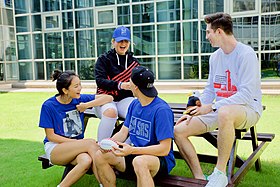
A student is a person enrolled in a school or other educational institution.
In the United Kingdom and most commonwealth countries, a "student" attends a secondary school or higher (e.g., college or university); those in primary or elementary schools are "pupils."
Africa
Nigeria
In Nigeria, education is classified into four systems known as a 6-3-3-4 system of education. It implies six years in primary school, three years in junior secondary, three years in senior secondary and four years in the university. However, the number of years to be spent in university is mostly determined by the course of study. Some courses have longer study lengths than others. Those in primary school are often referred to as pupils. Those in university, as well as those in secondary school, are referred to as students.
The Nigerian system of education also has other recognized categories like the polytechnics and colleges of education. The Polytechnic gives out National Diploma and Higher National Diploma certifications after two years and/or four years of study respectively.
A higher National Diploma (also known as HND) can be obtained in a different institution from where the National Diploma (also known as ND or OND) was obtained. However, the HND cannot be obtained without the OND certificate.
On the other hand, the respective colleges of education provide students with the Nigerian Certificate in Education (NCE) after two years of study.
South Africa

In South Africa, education is divided into four bands: the Foundation Phase (grades 1–3), the Intermediate Phase (grades 4–6), the Senior Phase (grades 7–9), and the Further Education and Training or FET Phase (grades 10–12). However, because this division is newer than most schools in the country, in practice, learners progress through three different types of school: Primary school (grades 1–3), Junior school (grades 4–7), and High school (grades 8–12). After the FET phase, learners who pursue further studies typically take three or four years to obtain an undergraduate degree or one or two years to achieve a vocational diploma or certificate. The number of years spent in university varies as different courses of study take different numbers of years. Those in the last year of high school (Grade 12) are referred to as 'Matrics' or are in 'Matric' and take the Grade 12 examinations accredited by the Umalusi Council (the South African board of education) in October and November of their Matric year. Exam papers are set and administered nationally through the National Department of Basic Education for government schools, while many (but not all) private school Matrics sit for exams set by the Independent Education Board (IEB), which operates with semi-autonomy under the requirements of Umalusi. (The assessment and learning requirements of both IEB and National exams are of roughly the same standard. The perceived better performance of learners within the IEB exams is largely attributable to their attending private, better-resourced schools with the much lower teacher: learner ratios and class sizes rather than because of fundamental differences in assessment or learning content). A school year for the majority of schools in South Africa runs from January to December, with holidays dividing the year into terms. Most public or government schools are 4-term schools and most private schools are 3-term school, but the 3-term government or public schools and 4-term private schools are not rare.
Asia
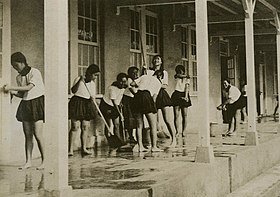
Singapore
Six years of primary school education in Singapore are compulsory.
- Primary School (Primary 1 to 6)
Primary 1 to 3 (aged 7–9 respectively, Lower primary) Primary 4 to 6 (aged 10–12 respectively, Upper primary)
- Secondary School (Secondary 1 to 4 or 5)
Sec 1s are 13, and Sec 4s are 16. Express Students take secondary school from Sec 1 to 4, and Normal Acad and Technical will take secondary school from Sec 1 to 5.
- Junior College (Junior College 1 to 2 – Optional) OR Polytechnic (3 years – Optional)
There are also schools which have the integrated program, such as River Valley High School (Singapore), which means they stay in the same school from Secondary 1 to Junior College 2, without having to take the "O" level examinations which most students take at the end of secondary school.
International schools are subject to overseas curriculums, such as the British, American, Canadian or Australian Boards.
Bangladesh
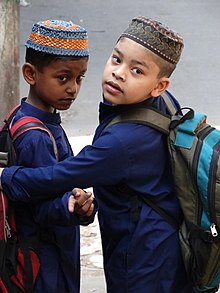
Primary education is compulsory in Bangladesh. It is a near crime to not to send children to primary school when they are of age, but it is not a punishable crime. Sending children to work instead of school is a crime, however. Because of the socio-economic state of Bangladesh, child labour is sometimes legal, but the guardian must ensure the primary education of the child. Anyone who is learning in any institute or even online may be called a student in Bangladesh. Sometimes students taking undergraduate education are called undergraduates and students taking post-graduate education may be called post-graduates.
Education system of Bangladesh:
| Educational Level | Grade | Age | |
|---|---|---|---|
| Primary (elementary school) | 1 to 5 | 6 to 10 | |
| Junior Secondary (middle school) | 6 to 8 | 11 to 13 | |
| Secondary (high school) | 9 to 10 | 14 to 15 | |
| Higher Secondary (college/university) | 11 to 12 | 16 to 17 |
Brunei
Education is free in Brunei. Darussalam not limited to government educational institutions but also private educational institutions. There are mainly two types of educational institutions: government or public, and private institutions. Several stages have to be undergone by the prospective students leading to higher qualifications, such as bachelor's degree.
- Primary School (Year 1 to 6)
- Secondary School (Year 7 to 11)
- High School (Year 12 to 13)
- Colleges (Pre-University to Diploma)
- University Level (Undergraduate, Postgraduate and Professional)
It takes six and five years to complete the primary and secondary levels respectively. Upon completing these two crucial stages, students/pupils have freedom to progress to sixth-form centers, colleges or probably straight to employment. Students are permitted to progress towards university level programs in both government and private university colleges.
Cambodia
Education in Cambodia is free for all students who study in Primary School, Secondary School or High School.
- Primary School (Grade 1 to 6)
- Secondary School (Grade 7 to 9)
- High School (Grade 10 to 12)
- College (Year 1 to 3)
- University (Year 1 to 4 or 5)
After basic education, students can opt to take a bachelor's (undergraduate) degree at a higher education institution (i.e. a college or university), which normally lasts for four years, though the length of some courses may be longer or shorter depending on the institution.
India
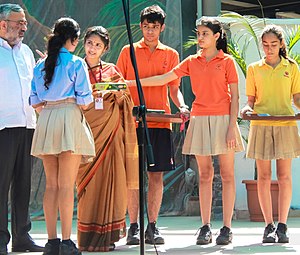
In India school is categorized in these stages: Pre-primary (Nursery, Lower Kindergarten or LKG, Upper Kindergarten or UKG), Primary (Class 1–5), Secondary (6–10) and Higher Secondary (11–12). For undergraduate it is 3 years except Engineering (BTech or BE), Pharmacy (B.pharm), Bsc agriculture which are 4-year degree course, Architecture (B.Arch.) which is a 5-year degree course, M.Sc. (5-year Integrated courses) and Medical (MBBS) which consists of a 4.5-year degree course and a 1-year internship, so 5.5 years in total.
Nepal
In Nepal 12-year school is categorised in two stages: Primary school (Grade 1 to Grade 8) and Higher Secondary school (Grade 9 to Grade 12). For college it averages four years for a bachelor's degree (except BVSc and AH which are five year programmes and MBBS which is a five and half year programme) and two years master's degree.
Pakistan
In Pakistan, 12-year school is categorized in three stages: Primary school, Secondary school and Higher Secondary school. It takes five years for a student to graduate from Primary school, five years for Secondary school and five years for Higher Secondary school (also called College). Most bachelor's degrees span over four years, followed by a two years master's degree.
Philippines
The Philippines is currently in the midst of a transition to a K-12 (also called K+12) basic education system. Education ideally begins with one year of kinder. Once the transition is complete, elementary or grade school comprises grades 1 to 6. Although the term student may refer to learners of any age or level, the term 'pupil' is used by the Department of Education to refer to learners in the elementary level, particularly in public schools. Secondary level or high school comprises two major divisions: grades 7 to 10 will be collectively referred to as 'junior high school', whereas grades 11 to 12 will be collectively referred to as 'senior high school'. The Department of Education refers to learners in grade 7 and above as students.
After basic education, students can opt to take a bachelor's (undergraduate) degree at a higher education institution (i.e. a college or university), which normally lasts for four years though the length of some courses may be longer or shorter depending on the institution.
Iran
In Iran 12-year school is categorized in two stages: Elementary school and High school. It takes six years for a student to graduate from elementary school and six years for high school. High school study is divided into two part: junior and senior high school. In senior high school, students can choose between the following six fields: Mathematics and physics, Science, Humanities, Islamic science, Vocational, or Work and Knowledge. After graduating from high school, students acquire a diploma. Having a diploma, a student can participate in the Iranian University Entrance Exam or Konkoor in different fields of Mathematics, Science, Humanities, languages, and art. The university entrance exam is conducted every year by National Organization of Education Assessment, an organization under the supervision of the Ministry of Science, Research and Technology which is in charge of universities in Iran. Members of the Baháʼí Faith, a much-persecuted minority, are officially forbidden to attend university, in order to prevent members of the faith becoming doctors, lawyers or other professionals; however, Muslim, Christian, Jewish, and Zoroastrian people are allowed entry to universities.
Oceania
Australia
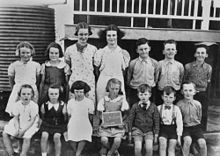
In Australia, Pre-school is optional for three and four year olds. At age five, children begin compulsory education at Primary School, known as Kindergarten in New South Wales, Preparatory School (prep) in Victoria, and Reception in South Australia, students then continue to year one through six (ages 6 to 12). Before 2014, primary school continued on to year seven in Western Australia, South Australia and Queensland. However, the state governments agreed that by 2014, all primary schooling will complete at year six. Students attend High School in year seven through twelve (ages 13 – 18). After year twelve, students may attend tertiary education at university or vocational training at TAFE (Technical and Further Education).
New Zealand
In New Zealand, after kindergarten or pre-school, which is attended from ages three to five, children begin primary school, 'Year One', at five years of age. Years One to Six are Primary School, where children commonly attend local schools in the area for that specific year group. Then Year Seven and Year Eight are Intermediate, and from Year Nine until Year Thirteen, a student would attend a secondary school or a college.
Europe
Europe uses the traditional, first form, second form, third form, fourth form, fifth form and six form grade system which is up to age eleven.
Finland

In Finland a student is called "opiskelija" (plural being 'opiskelijat'), though children in compulsory education are called "oppilas" (plural being 'oppilaat'). First level of education is "esikoulu" (literally 'preschool'), which used to be optional, but has been compulsory since the beginning of year 2015. Children attend esikoulu the year they turn six, and next year they start attending "peruskoulu" (literally "basic school", corresponds to American elementary school, middle school and junior high), which is compulsory. Peruskoulu is divided to "alakoulu" (years 1 through 6) and "yläkoulu" (years 7 through 9). After compulsory education most children attend second-level education (toisen asteen koulutus), either lukio (corresponds to high school) or ammattioppilaitos (Vocational School), at which point they are called students (opiskelija). Some attend "kymppiluokka", which is a retake on some yläkoulu's education.
To attend ammattikorkeakoulu (University of applied sciences) or a university a student must have a second-level education. The recommended graduation time is five years. First year students are called "fuksi" and students that have studied more than five years are called "N:nnen vuoden opiskelija" (Nth year student).
France
The generic term "étudiant" (lit. student) applies only to someone attending a university or a school of a similar level, that is to say pupils in a cursus reserved to people already owning a Baccalauréat. The general term for a person going to primary or secondary school is élève. In some French higher education establishments, a bleu or "bizuth" is a first-year student. Second-year students are sometimes called "carrés" (squares). Some other terms may apply in specific schools, some depending on the classe préparatoire aux grandes écoles attended.
Germany
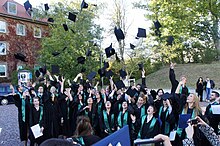
In Germany, the German cognate term Student (male) or "Studentin" (female) is reserved for those attending a university. University students in their first year are called Erstsemester or colloquially Ersties ("firsties"). Different terms for school students exist, depending on which kind of school is attended by the student. The general term for a person going to school is Schüler or Schülerin. They begin their first four (in some federal estates six) years in primary school or Grundschule. They then graduate to a secondary school called Gymnasium, which is a university preparatory school. Students attending this school are called Gymnasiasten, while those attending other schools are called Hauptschüler or Realschüler. Students who graduate with the Abitur are called Abiturienten.
Ireland
In Ireland, pupils officially start with primary school which consists of eight years: junior infants, senior infants, first class to sixth class (ages 5–11). After primary school, pupils proceed to the secondary school level. Here they first enter the junior cycle, which consists of first year to third year (ages 11–14). At the end of third year, all students must sit a compulsory state examination called the Junior Certificate. After third year, pupils have the option of taking a "transition year" or fourth year (usually at age 15–16). In transition year pupils take a break from regular studies to pursue other activities that help to promote their personal, social, vocational and educational development, and to prepares them for their role as autonomous, participative and responsible members of society. It also provides a bridge to enable pupils to make the transition from the more dependent type of learning associated with the Junior Cert. to the more independent learning environment associated with the senior cycle.
After the junior cycle pupils advance to the senior cycle, which consists of fifth year and sixth year (usually ages between 16 and 18). At the end of the sixth year a final state examination is required to be sat by all pupils, known as the Leaving Certificate. The Leaving Cert. is the basis for all Irish pupils who wish to do so to advance to higher education via a points system. A maximum of 625 points can be achieved. All higher education courses have a minimum of points needed for admission.
At Trinity College Dublin under-graduate students are formally called "junior freshmen", "senior freshmen", "junior sophister" or "senior sophister", according to the year they have reached in the typical four year degree course. Sophister is another term for a sophomore, though the term is rarely used in other institutions and is largely limited to Trinity College Dublin.
At university, the term "fresher" is used to describe new students who are just beginning their first year. The term, "first year" is the more commonly used and connotation-free term for students in their first year. The week at the start of a new year is called "Freshers' Week" or "Welcome Week", with a programme of special events to welcome new students. An undergraduate in the last year of study before graduation is generally known as a "finalist".
Italy
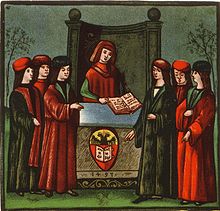
In Italian, a matricola is a first-year student. Some other terms may apply in specific schools, some depending on the liceo classico or liceo scientifico attended.
According to the goliardic initiation traditions the grades granted (following approximately the year of enrollment at university) are: matricola (freshman), fagiolo (sophomore), colonna (junior), and anziano (senior), but most of the distinctions are rarely used outside Goliardia.
Sweden
In Sweden, only those studying at university level are called students (student, plural studenter). To graduate from upper secondary school (gymnasium) is called ta studenten (literally "to take the student"), but after the graduation festivities, the graduate is no longer a student unless he or she enrolls at university-level education. At lower levels, the word elev (plural elever) is used. As a general term for all stages of education, the word studerande (plural also studerande) is used, meaning 'studying '.
United Kingdom
| This section does not cite any sources. Please help improve this section by adding citations to reliable sources. Unsourced material may be challenged and removed. (September 2020) (Learn how and when to remove this message) |
Traditionally, the term "student" is reserved for people studying at university level in the United Kingdom.
At universities in the UK, the term "fresher" is used informally to describe new students who are just beginning their first year. Although it is not unusual to call someone a fresher after their first few weeks at university, they are typically referred to as "first years" or "first year students".
The ancient Scottish University of St Andrews uses the terms "bejant" for a first year (from the French "bec-jaune" – "yellow beak", "fledgling"). Second years are called "semi-bejants", third years are known as "tertians", and fourth years, or others in their final year of study, are called "magistrands".
In England and Wales, primary school begins with an optional "nursery" year (either in a primary school or a privately run nursery,) followed by reception and then move on to "year one, year two" and so on until "year six" (all in primary school.) In state schools, children join secondary school when they are 11–12 years old in what used to be called "first form" and is now known as "year 7". They go up to year 11 (formerly "fifth form") and then join the sixth form, either at the same school or at a separate sixth form college. A pupil entering a private, fee-paying school (usually at age 13) would join the "third form" – equivalent to year 9. Many schools have an alternate name for first years, some with a derogatory basis, but in others acting merely as a description – for example "shells" (non-derogatory) or "grubs" (derogatory).
In Northern Ireland and Scotland, it is very similar but with some differences. Pupils start off in nursery or reception aged 3 to 4, and then start primary school in "P1" (P standing for primary) or year 1. They then continue primary school until "P7" or year 7. After that they start secondary school at 11 years old, this is called "1st year" or year 8 in Northern Ireland, or "S1" in Scotland. They continue secondary school until the age of 16 at "5th year", year 12 or "S5", and then it is the choice of the individual pupil to decide to continue in school and (in Northern Ireland) do AS levels (known as "lower sixth") and then the next year to do A levels (known as "upper sixth"). In Scotland, students aged 16–18 take Highers, followed by Advanced Highers. Alternatively, pupils can leave and go into full-time employment or to start in a technical college.
Large increases in the size of student populations in the UK and the effect this has had on some university towns or on areas of cities located near universities have become a concern in the UK since 2000. A report by Universities UK, Studentification: A Guide to Opportunities, Challenges and Practice (2006) has explored the subject and made various recommendations. A particular problem in many locations is seen as the impact of students on the availability, quality and price of rented and owner-occupied property.
Americas
Canada
Further information: Education in Canada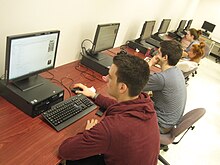
Education in Canada (a federal state) is primarily within the constitutional jurisdiction of the provinces. The overall school curricula are overseen by the provincial and territorial governments, therefore the way educational stages are grouped and named can differ. Education is generally divided into primary, secondary and post-secondary stages. Primary and secondary education are generally divided into annual grades from 1 to 12, although grade 1 may be preceded by one or two years of kindergarten (which may be optional). Specifically, Ontario, Quebec and the Northwest Territories offer junior then senior kindergarten (in French, either pre-maternelle then maternelle, or maternelle then jardin d'enfants).
Education in Ontario from 1988 involved an Ontario Academic Credit (OAC) after grade 12 primarily as university preparation, but that was phased out in 2003. The OAC was informally known as "grade 13" (which it had replaced). All provinces and territories except Quebec now have 12 grades.
Education in Quebec differs from the other jurisdictions in that it has an école primaire ("primary school") consisting of grades 1–6 and an école secondaire ("secondary school") consisting of secondaries I–V, equivalent to grades 7–11. A student graduating from école secondaire then either completes a three-year college program or a two-year pre-university program required before attending university. In some English-language écoles secondaire and most French-language écoles secondaire, students refer to secondaries I–V as years one through five. This can be confusing for those outside of Quebec, especially out of context.
In some provinces, grades 1 through 5 are called "elementary school", grades 6 to 8 are called "middle school" or "junior high school", and grades 9 to 12 are considered high school. Other provinces, such as British Columbia, mainly divide schooling into elementary school (Kindergarten to grade 7) and secondary school (grades 8 through 12). In Alberta and Nova Scotia, elementary consists of kindergarten through grade 6. Junior high consists of Grades 7–9. High school consists of Grades 10–12. In English provinces, the high school (known as academy or secondary school) years can be referred to simply as first, second, third and fourth year. Some areas call it by grade such as grade 10, grade 11 and grade 12.
In Canadian English, the term "college" usually refers to a technical, trades, applied arts, applied technology, or applied science school or community college. These are post-secondary institutions typically granting two-year diplomas certificates, diplomas, associate degrees and (in some cases) bachelor's degrees. The French acronym specific to public institutions within Quebec's system of pre-university and technical education is CEGEP (Collège d'enseignement général et professionnel, "college of general and professional education"). CEGEP is a collegiate level institution in Quebec that most students typically enrols in, whether to learn a trade or applied discipline or to qualify for entrance to university in the Quebec education system. (In Ontario and Alberta, there are also institutions that only grant undergraduate degrees which are designated university colleges to differentiate them from universities, which have both undergraduate and graduate programs.)
In Canada, there is a strong distinction between "college" and "university". In conversation, one specifically would say either "they are going to university" (i.e., studying for a three- or four-year degree at a university) or "they are going to college" (i.e., studying at a technical/career training).
A Canadian post-secondary college is generally geared for individuals seeking applied careers, while universities are geared for individuals seeking more academic careers.
University students are generally classified as first, second, third or fourth-year students, and the American system of classifying them as "freshmen", "sophomores", "juniors" and "seniors" is seldom used or even understood in Canada. In some occasions, they can be called "senior ones", "twos", "threes" and "fours".
United States


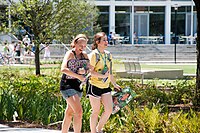 Students of Tulane University in the U.S. (from top to bottom): at its bookstore, in a class photo (with their teacher sitting on extreme right), and entering class
Students of Tulane University in the U.S. (from top to bottom): at its bookstore, in a class photo (with their teacher sitting on extreme right), and entering class
In the United States, the first official year of schooling is called kindergarten, which is why the students are called kindergarteners. Kindergarten is optional in most states, but few students skip this level. Pre-kindergarten, also known as "preschool" (and sometimes shortened to "Pre-K") is becoming a standard of education as academic expectations for the youngest students continue to rise. Many public schools offer pre-kindergarten programs.
In the United States, there are 12 years of mandatory schooling. The first eight are solely referred to by numbers (e.g. 1st grade, 5th grade) so students may be referred to as 1st graders, 5th graders, then once in middle school, they are referred to as 6th, 7th, and 8th graders. Upon entering high school, grades 9 through 12 (high school) also have alternate names for students, namely freshman, sophomore, junior and senior. The actual divisions of which grade levels belong to which division (whether elementary, middle, junior high, or high school) is a matter decided by state or local jurisdictions.
College students are often called Freshmen, Sophomores, Juniors, and Seniors for each of the four years unless their undergraduate program calls for more than the traditional four years.
First year
The first year of college or high school is referred to as Freshman year. A freshman is a first-year student in college, university or high school.
Second year
In the U.S., a sophomore, also called a "soph", is a second-year student. Outside the United States, the term sophomore is rarely used, with second-year students simply called "second years". Folk etymology indicates that the word means "wise fool"; consequently "sophomoric" means "pretentious, bombastic, inflated in style or manner; immature, crude, superficial" (according to the Oxford English Dictionary). It is widely assumed to be formed from Greek Sophos, meaning "wise", and Moros meaning "foolish", although the etymology suggests an origin from the now-defunct "sophomore", an obsolete variant of "sophism".
Post-second year

In the U.S., a Junior is a student in the penultimate (usually third) year and a Senior is a student in the last (usually fourth) year of college, university, or high school. A student who takes more than the average number of years to graduate is sometimes referred to as a "super senior". This term is often used in college but can be used in high school as well. The term underclassman refers collectively to Freshmen and Sophomores, and upperclassman refers collectively to Juniors and Seniors, sometimes even Sophomores. In some cases, the freshmen, sophomores, and juniors are considered underclassmen, while seniors are designated as upperclassmen. The term Middler is used to describe a third-year student of a school (generally college) that offers five years of study. In this situation, the fourth and fifth years would be referred to as Junior and Senior years, respectively, and the first two years would be the Freshman and Sophomore years.
Graduate students
A graduate student is a student who continues his/her education after graduation. Some examples of graduate programs are: business school, law school, medical school, and veterinary school. Degrees earned in graduate programs include the master's degree, a research doctoral degree, or a first professional degree.
Vocational school
Students attending vocational school focus on their jobs and learning how to work in specific fields of work. A vocational program typically takes much less time to complete than a four-year degree program, lasting 12–24 months.
Student politics
Student politicsStudents have their own current of politics and activism on and off campus. The student rights movement has centered itself on the empowerment of students similar to the labor movement.
Mature students
This section is an excerpt from Adult learner.An adult learner—or, more commonly, a mature student or mature-age student—is a person who is older and is involved in forms of learning. Adult learners fall in a specific criterion of being experienced, and do not always have a high school diploma. Many of the adult learners go back to school to finish a degree, or earn a new one.
Malcolm Knowles's work distinguished adult learners as distinct from adolescent and child learners in his principle of andragogy. He established 5 assumptions about the adult learner. This included self-concept, adult learner experience, readiness to learn, orientation to learning, and motivation to learning.Student pranks
Main article: Student prankUniversity students have been associated with pranks and japes since the creation of universities in the Middle Ages. These can often involve petty crime, such as the theft of traffic cones and other public property, or hoaxes. It is also not uncommon for students from one school to steal or deface the mascot of a rival school. In fact, pranks play such a significant part in student culture that numerous books have been published that focus on the issue.
Other terms
- Students who are repeating a grade level of schooling due to poor grades are sometimes referred to as having been "held back" or "kept back". In Malaysia and Singapore they are described as "retained". In the Philippines they are called "repeater".
- The term 'pupil' (originally a Latin term for a minor as the ward of an adult guardian, etc.) is used in some Commonwealth primary and secondary schools (particularly in England and Wales) instead of "student", but once attending further education (at a sixth-form college) or higher education (at university for example), the term "student" is standard. The term pupil is also used in the Philippines by the Department of Education to refer to learners currently in elementary school; the term student is used for by the Department of Education for learners in high school.
- The United States military academies officially use only numerical terms, but there are colloquial expressions used in everyday speech. In order from first year to fourth year, students are referred to as "fourth-class", "third-class", "second-class", and "first-class" cadets or midshipmen. Unofficially, other terms are used, for example at the United States Military Academy, freshmen are called "plebes", sophomores are called "yearlings" or "yuks", juniors are called "cows", and seniors are called "firsties". Some universities also use numerical terms to identify classes; students enter as "first-years" and graduate as "fourth-years" (or, in some cases, "fifth-years", "sixth-years", etc.).
Idiomatic use
"Freshman" and "sophomore" are sometimes used figuratively, almost exclusively in the United States, to refer to a first or second effort ("the singer's sophomore album"), or to a politician's first or second term in office ("freshman senator") or an athlete's first or second year on a professional sports team. "Junior" and "senior" are not used in this figurative way to refer to third and fourth years or efforts, because of those words' broader meanings of "younger" and "older". A junior senator is therefore not one who is in a third term of office, but merely one who has not been in the Senate as long as the other senator from their state. Confusingly, this means that it is possible to be both a "freshman senator" and a "senior senator" simultaneously: for example, if a senator wins election in 2008, and then the other senator from the same state steps down and a new senator elected in 2010, the former senator is both senior senator (having been in the Senate for two years longer) and a freshman senator (being still in their first term).
International Students' Day
International Students' Day (17 November) remembers the anniversary of the 1939 Nazi storming of the University of Prague after student demonstrations against the German occupation of Czechoslovakia. Germans closed all Czech universities and colleges, sent over 1200 students to Nazi concentration camps, and had nine student leaders executed (on 17 November).
See also
- Dormitory
- Freshman 15
- International student
- Learning
- School bullying
- Bullying in academia
- Bullying in teaching
- School uniform
- Student activism
- Student club
- Student orientation
- School counselor
- Student financial aid in the United States
- Study skills
- Tutor
- Studentification
- Teacher
- University student retention
- Youth
- Homeschooling
References
- "Student | Definition of Student by Oxford Dictionary on Lexico.com also meaning of Student". Lexico Dictionaries | English. Archived from the original on 27 September 2020. Retrieved 11 August 2020.
- "STUDENT | definition in the Cambridge English Dictionary". Cambridge Dictionary. Cambridge University Press. Archived from the original on 5 July 2019. Retrieved 9 April 2020.
- "Education in Nigeria". WENR. 7 March 2017. Archived from the original on 13 November 2019. Retrieved 25 October 2019.
- "Primary". Base. Archived from the original on 8 April 2021. Retrieved 2 April 2021.
- "Bangladesh Education System". scholaro pro. Archived from the original on 26 April 2016. Retrieved 30 April 2016.
- K to 12 Toolkit Archived 28 October 2020 at the Wayback Machine (PDF) Accessed 21 October 2016
- K to 12 Curriculum Guides Accessed 21 October 2016
- Republic Act 10533 Archived 12 April 2016 at the Wayback Machine (PDF) Accessed 21 October 2016
- Sanjesh.org Archived 7 October 2019 at the Wayback Machine In Arabic
- "وزارت علوم، تحقیقات و فناوری - صفحات - صفحه اصلی" [Ministry of Science, Research and Technology Pages Home]. Archived from the original on 3 December 2003. Retrieved 9 December 2012.
- Pelham, Lipika (18 January 2017). "Studying at the Bahai secret university". BBC News. Archived from the original on 1 February 2021. Retrieved 28 January 2021.
- "'Studentification': a guide to opportunities, challenges and practice" (PDF). 11 July 2009. Archived from the original (PDF) on 11 July 2009.
- "Online Etymology Dictionary". Etymonline.com. Archived from the original on 28 September 2006. Retrieved 8 December 2012.
- Definition of a super senior Archived 30 October 2006 at the Wayback Machine retrieved 5 October 2006.
- "Minnesota Vocational Schools, Trade Schools, Technical Schools - RWM.org". RWM - Real Work Matters. Archived from the original on 6 November 2011. Retrieved 6 October 2011.
- ^ Special Analysis 2002 – Nontraditional Undergraduates Archived April 16, 2007, at the Wayback Machine
- "Who is the Adult Learner?". Southern Regional Education Board. 10 December 2015. Retrieved 21 June 2017.
- "Seeley G. Mudd Manuscript Library: FAQ Student pranks". Princeton.edu. 24 April 2012. Archived from the original on 2 December 2012. Retrieved 8 December 2012.
- "Blog Archive » Student Pranks". Kiwiblog. 21 October 2006. Archived from the original on 27 September 2007. Retrieved 8 December 2012.
- Watts, Jonathan, "Student prank that gave the Chinese a fit of the willies", The Guardian, London, 1 November 2003.
- "Student Pranks! Attention!". Essaymama. 3 September 2014. Archived from the original on 4 December 2014. Retrieved 28 November 2014.
- Ayala, Jamie, "Sticky student prank injures teacher" Archived 2007-09-27 at the Wayback Machine, FOX11AZ.com, Tucson, Arizona, 14 June 2007.
- Tom (15 February 2014). "Nightmare on student street". DesignForm. Archived from the original on 11 July 2020. Retrieved 8 July 2020.
- Miller, Eli, "Oski and Tree Have Rowdy, Long History", The Daily Californian, 22 November 2002. Archived 20 September 2004 at the Wayback Machine
- Peterson, T.F., Nightwork: A History of Hacks and Pranks at MIT, 2003.
- Steinberg, Neil, If at All Possible, Involve a Cow: The Book
- "The 17th of November: Remembering Jan Opletal, martyr of an occupied nation Archived 5 September 2019 at the Wayback Machine". Radio Prague.